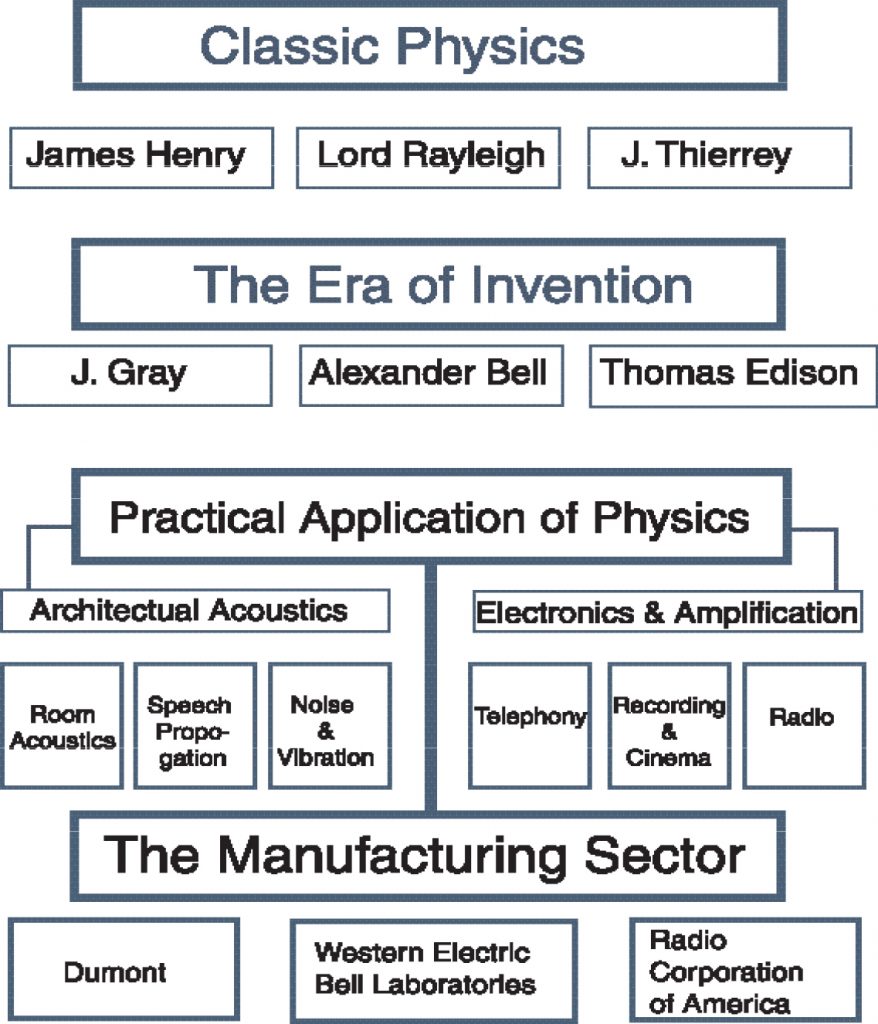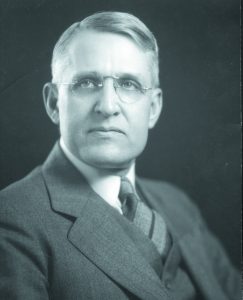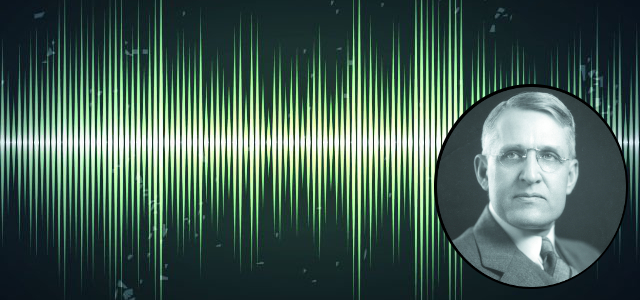By the end of the 19th Century, knowledge concerning the principles of physics had been developed sufficiently to permit the exploration of acoustics as a viable scientific exercise. The study of “acoustics” had been of continuing interest dating back to the 4th Century BC Greeks. However, it was necessary to conquer the basic principles of wave mechanics, thermodynamics, hydrodynamics and other conditions of classic physics before acoustics—which embraces at the least three (if not more) of the elements of physical science—could be adequately defined.
As Frederick V. Hunt was to write1:
“Sound waves are produced by the action of moving bodies in contact with air; but is not the motion of material bodies the proper concern of mechanics? Sound waves consist of pressure and velocity disturbances traveling in a compressible fluid; but are not motions and pressure distribution in fluids the proper concerns of hydrodynamics? The condensations and rarefactions that comprise sound waves give rise to regions of higher and lower temperature, between which heat may flow; but are not temperature changes and heat transfer the proper concerns of thermodynamics?” And so on….
A shift can be observed wherein the academic concerns of the classic physicists were being replaced by the more commercial endeavors of application-oriented inventors.
As the 19th Century drew to a close, many of the principles of “classic physics” had been, if not completely satisfied, at best properly defined. Electromagnetism had been isolated and harnessed to provide the communication marvels of telegraphy and telephony. A shift can be observed wherein the academic concerns of the classic physicists were being replaced by the more commercial endeavors of application-oriented inventors. Edison was openly disdainful of mathematicians and Bell was to lament that he was sorely deficient in mathematical operations. This invoked an era in which tinker-oriented inventors moved to the forefront while classic physics reverted to the safety of the academic community and started to take on the nature of studies in applied physics.
In view of the expanding knowledge related to acoustics and electromagnetic phenomena, it was understandable that the further pursuit of advancements would take divergent paths. Various disciplines sprang into being to promote the emerging paths of electromagnetic and acoustical sciences (see the graphic below).

Eventually, some of these divergent tangents would recombine and intermingle to become the diverse, multifaceted scene that represents today’s audio and communication industry.
The Quest For Men Of Science
Having emerged victorious from the “Telephone Wars,” the newly emerging telephone industry was in dire need of qualified technicians and scientists who could expand Bell Telephone’s virtual monopoly of the US and Canadian telephone networks. Little was known of the conditions of transmission characteristics because rudimentary knowledge about the volume (amplitude) of sound was in its infancy—the dB (Decibel) was not yet a measured phenomena. With thanks to Nikola Tesla and his work on transformer impedance principles, the transfer characteristics of transformer coupling was reasonably understood.
NOTE: In the near future we need to revisit the works of Tesla because he was perhaps one of the primary pioneers of electronic (and subsequently audio) technology.
In 1904, English physicist John Ambrose Fleming had developed the first successful vacuum tube. Essentially, this was a diode and, although useful for purposes of rectification, lacked the characteristics by which it could provide amplification principles. A few years later (1906), Lee Forest (1873-1961), an American engineer, would demonstrate successfully that, by introducing a control grid to the vacuum tube, the device could be used to control amplification of signal inputs.
Arnold and his project staff successfully transformed the primitive audion, which had little, if any, vacuum, into a workable device for audio amplification.
Bell Telephone was quick to recognize the value of this new invention in the improvement of their telephone network quality, and set about to recruit scientists with a background in this new area of “electron technology.” This quest for talent led Dr. Frank Jewett, Western Electric Vice President, to approach his University of Chicago alumni colleague, Dr. Robert Millikan, to recommend a qualified candidate for further pursuit of “electron technology”—as it might apply to the further development of telephony technology. Millikan was quick to suggest a graduate student, Dr. Harvey Fletcher, to be posted to the position. Fletcher had already proven his ability in the exploration of electron physics by participating with Millikan in the isolation and quantitizing of charged electrons2.
Western Electric, Fletcher Connection

Western Electric was quick to approach Fletcher with an offer to join their research staff. After being graduated summa cum laude from the University of Chicago in 1911, Fletcher chose to return to his alma mater, Brigham Young University, as chairman of the Physics Department. Fletcher (1884-1981) had been born into a devout Provo UT Mormon family and considered it his duty to serve as a mentor to succeeding generations of students at BYU.
Nevertheless, the offers from Western Electric continued. Jewett was to renew his offer for Fletcher to accept a Western Electric assignment every January. Fletcher routinely declined. In the meantime, Western Electric surged onward in their quest to improve the quality of their telephone network and enlarge its scope toward being a transcontinental and intercontinental service. Obviously, some form of amplification would be required before they could reach their goals. In 1912, Fritz Lowenstein demonstrated De Forest’s audion amplifier to Bell officials. Promptly, a project was organized under Dr. H.D. Arnold, who had also been a student of Millikan’s at U of C and a contemporary of Fletcher. Arnold and his project staff successfully transformed the primitive audion, which had little, if any, vacuum, into a workable device for audio amplification. Arnold’s vacuum tube amplifiers were deployed into the Bell Network beginning on January 1, 1915.
Fletcher was later to reflect in an unpublished biography to his family that this advance in science might have been his had he chosen to pursue an earlier career with Western Electric3. His comments were without rancor and represented merely an observation on those things that might have been.
Fletcher watched these developments with considerable interest and was well aware that electronics would play a major role in improving communications. He was also starting to realize that his potential was not being fully addressed in his position at BYU. Thus, when Jewett’s annual January offer arrived in 1916, Fletcher accepted. He packed his bags and his household and headed east. He was to spend the next 33 years of his life delving into the principles of speech and communication intelligibility on the behalf of Western Electric.
Between 1920 and 1923, Drs. Fletcher, Wengel and Wente set about to define the measurement standards of loudness and articulation, and to produce the necessary measurement instrumentation that could be used to quantify these phenomena.
From the very beginning, Bell Telephone (later American Telephone & Telegraph—AT&T) recognized that its challenge was to build the best telephone system in the world and that understanding how speech was degraded by the network was an important element in creating a premier mode of telephone transmission. World War I (1914-1918) interrupted commercial development of telephone transmission, but ushered in a new era in transmission theory by virtue of the government’s interest in communication principles. Fletcher and his mentor and colleague at Western Electric, I.B. Crandall, turned their attention to military acoustical resource programs.
Improving The Network With Applied Physics
At the conclusion of the war, Bell Telephone begin to resume its vigorous pursuit of improving the telephone transmission network. At the time, only crude measurements of speech transmission were understood, and instrumentation for the measurement of such criteria was not yet defined or developed. Between 1920 and 1923, Drs. Fletcher, Wengel and Wente set about to define the measurement standards of loudness and articulation, and to produce the necessary measurement instrumentation that could be used to quantify these phenomena4. Their efforts were to result in the definition of the measurements that would define both loudness and articulation. This lead to a means whereby they could measure noise as an additive condition to human hearing.
Although Fletcher was an amenable and pleasant individual, his co-workers and colleagues had difficulty addressing him. He seemed too intimate to be referred to as Doctor and too esteemed to be addressed as Harvey; hence he came to be known as Uncle Harvey to his associates—a term that seemed to please him and gave gratification to his co-workers. Beyond his professional exploits, Uncle Harvey had an exceptionally well rounded and satisfying personal life. Fletcher and his wife, Lorena Chipman, had six children—five sons and one daughter, who grew up to assume exceptional roles in their own rights. One son, James Chipman Fletcher, was to assume the role of director of the National Aeronautical Space Administration (NASA) for two terms, and then assumed the role of president of the University of Utah from 1964 to 1971. Mrs. Fletcher was to be twice awarded the citation of national Mother of the Year, and Dr. Fletcher joined in her acclaim by being voted Father of the Year.
By 1926, Fletcher was to realize that loudness was not the only criteria by which the transmission of speech could be classified. The concepts of articulation, intelligibility, frequency distortion and transmission noise levels were recognized as being elements in the transmission chain.
In 1923, Dr. Fletcher wrote5:
“In the telephone business, the commodity being delivered to the customer is reproduced speech. One of the most important qualities of this speech is its loudness, so it is reasonable to use a sensation scale to define the volume of the speech delivered.”
In that same paper, he defined the fact that a 1 dB change in level is the humanly perceptible change in volume intensity, i.e., that change in volume that can be perceived by the human ear.
By 1926, Fletcher was to realize that loudness was not the only criteria by which the transmission of speech could be classified. The concepts of articulation, intelligibility, frequency distortion and transmission noise levels were recognized as being elements in the transmission chain. These realizations prompted him and others at Bell Labs6 to begin experimenting with high- and low-pass filters to improve speech articulation. Through a series of mathematical calculations, he proved that the employment of speech filters would improve speech intelligibility with negligible effects on frequency-response characteristics. These calculations, put into practice, materially increased the articulation content of the telephone network.
Additional Accomplishments
In 1928, Floyd Watson, a professor of physics at the University of Illinois, and Wallace Waterfall, one of Watson’s previous students who was by then with Celotex Corporation in Chicago, set out by train to visit with Vern O. Knudsen, a professor of physics at UCLA. Out of that meeting was the formulation of what is now known as the Acoustical Society of America. The three founders recruited Dr. Harvey Fletcher to be the first president of the newly formed society. “Uncle Harvey” accepted the position and was instrumental in the formulation and development of what is now an esteemed organization7.
In 1929, Fletcher published his first book, Speech and Hearing, which summarized many of the experiments and discoveries that he and his colleagues at Western Electric (Bell Labs) had determined over the previous decade. In his 1929 works, there was considerable allusion to the establishment of an articulation index. However, many of these materials were held as confidential internal documents at AT&T and were not fully disclosed until publication in 1947.
The Physics Of Loudness
Fletcher and Munson published their now famous “Fletcher/Munson Loudness Curves” as part of an important paper in 1933, which established the now familiar set of curves that define by and large how the human ear relates intensity of sound to frequency and bandwidth. The publication of these works stirred up a fair amount of controversy during the 1930s as to the methodology employed in the testing process. The Fletcher/Munson curves have stood the test of time, though, and were used successfully during World War II as criteria for the development of aircraft radio and intercom transmitters and receivers.
Fletcher attained the position of director of Acoustical Research at Bell Labs after the death of Crandall in 1928, a position he was to hold until his retirement in 1949. In addition to his work in auditory perspectives as it related to telephony, Fletcher also was instrumental in the first stereophonic transmission of radio broadcasts. Several of the photographs in the Fletcher collection at the University of Utah’s Marriott Library depict Fletcher and other members of the Western Electric (IRPI) staff participating in the 1933 stereophonic sound reinforcement of Leopold Stokowski’s Hollywood Bowl Concert.
During the war, he served under Dr. Leo Beranek at the Electro-Acoustic Labs at Harvard University. Beranek was to also succumb to the habit of referring to him as “Uncle Harvey” and recalls that he was both a friendly guide and a demanding scientific critic. For his services to his country, Fletcher received a Certificate of Merit Award from President Harry S. Truman.
Fletcher and Munson published their “Fletcher/Munson Loudness Curves” as part of an important paper in 1933, which established the now familiar set of curves that define by and large how the human ear relates intensity of sound to frequency and bandwidth.
After his retirement from AT&T, Fletcher returned to his beloved BYU and resumed his 33-year hiatus by re-joining the physics faculty. In 1953, he republished his earlier (1929) book and renamed it Speech and Hearing in Communications8. In the preface to his 1953 edition, Fletcher remarks:
“About 35 years ago the Research Laboratories of the Bell Telephone System started a comprehensive research program on speech and hearing, and its relation to the design of telephone systems. It was apparent that great advantage would come if one could describe accurately every part of the system, namely (1) the talker, (2) the microphone, (3) the electrical transmission line, (4) the telephone receiver [headphone or terminating loudspeaker] and (5) the listener.”
Fletcher’s Legacy In Audio Science
Fletcher devoted his life’s work to examining and developing these phenomena and seeking the ways and means whereby speech transmission could be materially improved. Like Bell (Alexander Graham), Fletcher’s family had experienced a severe case of hearing disability. His father had been struck deaf at the age of 50, and this experience may well have influenced his pursuit of those conditions that define hearing and articulation.
Jont Allen summarized Fletcher’s accomplishments:
“Bell invented the telephone, and Edison made it into a practical device. Harvey Fletcher may not be as well known as these men today, but his scientific contributions to the field of telephony, hearing, and human communications are absolutely unsurpassed…. I would describe Harvey Fletcher as the singular intellectual force in the development of present-day communications acoustics and telephony.”9
Dr. Harvey Fletcher died at the age of 96 on July 23, 1981. His papers and many of his personal artifacts are on deposit with the Marriott Library at the University of Utah10.
Sidebar: “System Gain”
As an interesting historical note, “system gain” was described initially in terms of the variation in mils of a standard telephone cable, using as a reference a standard telephone set of that era. For example, the output of a condenser (electro-static) microphone of the period is rated at 65 mils below zero level. The transmission unit (TU) was adopted in 1923 and the dB was defined in 1920. The volume unit (VU) was not to find widespread use until 194011.
Sidebar: Not Too Scientific?
Bill Raventos, a well-known figure in our industry and currently serving as director of marketing for Ivie Technologies, Inc., in Orem, Utah, relates the following tale:
When Raventos saw “Uncle Harvey” at a local social event a few years prior to Fletcher’s death and introduced himself, the two began a friendly and somewhat drawn-out conversation during which Raventos commented on the Fletcher/Munson works of 1933. This drew from Dr. Fletcher something akin to a chuckle and his commentary was to the effect that their studies were probably not too scientific inasmuch as they had “rounded-up” whatever subjects they could find among the Bell Lab employees and had not screened them. He added that his “control group” was quite small, and that virtually all the subjects were 60 years of age or older.
The Law of averages seems to have worked remarkably well for Fletcher and Munson.
References
1 Hunt, Frederick Vinton, Origins in Acoustics, 1978 Yale University (republished by The Acoustical Society of America 1992) ISBN 0-300-02220-4
2 Allen, Jont B. Journal Acoustical Society of America, 99 (4) Pt. 1 April 1996
3 Fletcher, Harvey Dr., Speech and Hearing in Communications, edited by Allen Jont B. originally published by Van Nostrand, NYC 1953; republished by the Acoustical Society of America, 1995; ISBN 1-56396-393-0-(hbk)
4 Fletcher, 1920, Fletcher and Wengel, 1922a, 1923b; Fletcher, 1922c; AT&T internal documents. Allen, 99 (4), Pt. 1, 4-96. Jont B. J. Acoustical Society of America
5 Fletcher, 1923b (AT&T internal memorandums)
6 Bell Laboratories was formed on January 1, 1925
7 Newsletter of the Acoustical Society of America, Vol. 3, No,. 2, Summer 1993; Woodbury NY
8 Fletcher, Harvey B. Speech and Hearing in Communications, Van Nostrand, NYC 1953. Republished by the ASA, 1995. ISBN 1-56396-393-0 (hbk)
9 Allen, Jont, B. Ibid
10 Appreciation is extended to the staff at the University of Utah’s J. Willard Marriott Library for their assistance in providing materials for this article.
11 Hilliard, John K. Anthology on Sound Reinforcement, Journal of the Audio Engineering Society, Vol. 1 through 26, page A-39, New York NY. 1978
This article was originally published in the October 2000 issue of Sound & Communications.
Click here for more of Sound & Communications’ “Industry Pioneers” series.
